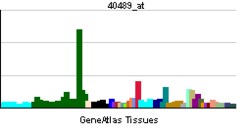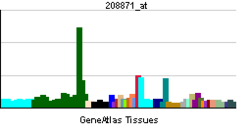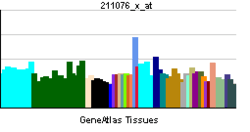ATN1
| Atrophin 1 | |||||||||||||
|---|---|---|---|---|---|---|---|---|---|---|---|---|---|
| Identifiers | |||||||||||||
| Symbols | ATN1 ; B37; D12S755E; DRPLA; HRS; NOD | ||||||||||||
| External IDs | OMIM: 607462 MGI: 104725 HomoloGene: 1461 GeneCards: ATN1 Gene | ||||||||||||
| |||||||||||||
| RNA expression pattern | |||||||||||||
 | |||||||||||||
 | |||||||||||||
 | |||||||||||||
| More reference expression data | |||||||||||||
| Orthologs | |||||||||||||
| Species | Human | Mouse | |||||||||||
| Entrez | 1822 | 13498 | |||||||||||
| Ensembl | ENSG00000111676 | ENSMUSG00000004263 | |||||||||||
| UniProt | P54259 | O35126 | |||||||||||
| RefSeq (mRNA) | NM_001007026 | NM_007881 | |||||||||||
| RefSeq (protein) | NP_001007027 | NP_031907 | |||||||||||
| Location (UCSC) | Chr 12: 7.03 – 7.05 Mb | Chr 6: 124.74 – 124.76 Mb | |||||||||||
| PubMed search | |||||||||||||
Atrophin-1 is a protein that in humans is encoded by the ATN1 gene. It is expressed in nervous tissue.
Function
Dentatorubral pallidoluysian atrophy is a rare neurodegenerative disorder characterized by cerebellar ataxia, myoclonic epilepsy, choreoathetosis, and dementia. The disorder is related to the expansion of a trinucleotide repeat within this gene. The encoded protein includes a serine repeat and a region of alternating acidic and basic amino acids, as well as the variable glutamine repeat. Alternative splicing results in two transcripts variants that encode the same protein.[1]
Clinical significance
Mutations in ATN1 are associated with a form of trinucleotide repeat disorder known as "dentatorubral-pallidoluysian atrophy" or "dentatorubropallidoluysian atrophy".
Interactions
ATN1 has been shown to interact with:
References
- ↑ "Entrez Gene: ATN1 atrophin 1".
- ↑ Okamura-Oho Y, Miyashita T, Ohmi K, Yamada M (June 1999). "Dentatorubral-pallidoluysian atrophy protein interacts through a proline-rich region near polyglutamine with the SH3 domain of an insulin receptor tyrosine kinase substrate". Hum. Mol. Genet. 8 (6): 947–57. doi:10.1093/hmg/8.6.947. PMID 10332026.
- ↑ 3.0 3.1 3.2 Wood JD, Yuan J, Margolis RL, Colomer V, Duan K, Kushi J, Kaminsky Z, Kleiderlein JJ, Sharp AH, Ross CA (June 1998). "Atrophin-1, the DRPLA gene product, interacts with two families of WW domain-containing proteins". Mol. Cell. Neurosci. 11 (3): 149–60. doi:10.1006/mcne.1998.0677. PMID 9647693.
- ↑ Yanagisawa H, Bundo M, Miyashita T, Okamura-Oho Y, Tadokoro K, Tokunaga K, Yamada M (May 2000). "Protein binding of a DRPLA family through arginine-glutamic acid dipeptide repeats is enhanced by extended polyglutamine". Hum. Mol. Genet. 9 (9): 1433–42. doi:10.1093/hmg/9.9.1433. PMID 10814707.
Further reading
- Wang L, Rajan, H, Pitman J, McKeown M and Tsai CC (2006). "Histone deacetylase-associating Atrophin proteins are nuclear receptor corepressors". Genes & Development 20 (5): 525–30. doi:10.1101/gad.1393506. PMC 1410805. PMID 16481466.
- Onodera O; Oyake M; Takano H et al. (1995). "Molecular cloning of a full-length cDNA for dentatorubral-pallidoluysian atrophy and regional expressions of the expanded alleles in the CNS". Am. J. Hum. Genet. 57 (5): 1050–60. PMC 1801383. PMID 7485154.
- Yazawa I; Nukina N; Hashida H et al. (1995). "Abnormal gene product identified in hereditary dentatorubral-pallidoluysian atrophy (DRPLA) brain". Nat. Genet. 10 (1): 99–103. doi:10.1038/ng0595-99. PMID 7647802.
- Nagafuchi S; Yanagisawa H; Ohsaki E et al. (1995). "Structure and expression of the gene responsible for the triplet repeat disorder, dentatorubral and pallidoluysian atrophy (DRPLA)". Nat. Genet. 8 (2): 177–82. doi:10.1038/ng1094-177. PMID 7842016.
- Burke JR; Wingfield MS; Lewis KE et al. (1994). "The Haw River syndrome: dentatorubropallidoluysian atrophy (DRPLA) in an African-American family". Nat. Genet. 7 (4): 521–4. doi:10.1038/ng0894-521. PMID 7951323.
- Nagafuchi S; Yanagisawa H; Sato K et al. (1994). "Dentatorubral and pallidoluysian atrophy expansion of an unstable CAG trinucleotide on chromosome 12p". Nat. Genet. 6 (1): 14–8. doi:10.1038/ng0194-14. PMID 8136826.
- Koide R; Ikeuchi T; Onodera O et al. (1994). "Unstable expansion of CAG repeat in hereditary dentatorubral-pallidoluysian atrophy (DRPLA)". Nat. Genet. 6 (1): 9–13. doi:10.1038/ng0194-9. PMID 8136840.
- Li SH; McInnis MG; Margolis RL et al. (1993). "Novel triplet repeat containing genes in human brain: cloning, expression, and length polymorphisms". Genomics 16 (3): 572–9. doi:10.1006/geno.1993.1232. PMID 8325628.
- Ansari-Lari MA; Muzny DM; Lu J et al. (1996). "A gene-rich cluster between the CD4 and triosephosphate isomerase genes at human chromosome 12p13". Genome Res. 6 (4): 314–26. doi:10.1101/gr.6.4.314. PMID 8723724.
- Takano T, Yamanouchi Y, Nagafuchi S, Yamada M (1996). "Assignment of the dentatorubral and pallidoluysian atrophy (DRPLA) gene to 12p 13.31 by fluorescence in situ hybridization". Genomics 32 (1): 171–2. doi:10.1006/geno.1996.0100. PMID 8786114.
- Yanagisawa H; Fujii K; Nagafuchi S et al. (1997). "A unique origin and multistep process for the generation of expanded DRPLA triplet repeats". Hum. Mol. Genet. 5 (3): 373–9. doi:10.1093/hmg/5.3.373. PMID 8852663.
- Margolis RL; Li SH; Young WS et al. (1996). "DRPLA gene (atrophin-1) sequence and mRNA expression in human brain". Brain Res. Mol. Brain Res. 36 (2): 219–26. doi:10.1016/0169-328X(95)00241-J. PMID 8965642.
- Ansari-Lari MA; Shen Y; Muzny DM et al. (1997). "Large-scale sequencing in human chromosome 12p13: experimental and computational gene structure determination". Genome Res. 7 (3): 268–80. doi:10.1101/gr.7.3.268. PMID 9074930.
- Miyashita T; Okamura-Oho Y; Mito Y et al. (1997). "Dentatorubral pallidoluysian atrophy (DRPLA) protein is cleaved by caspase-3 during apoptosis". J. Biol. Chem. 272 (46): 29238–42. doi:10.1074/jbc.272.46.29238. PMID 9361003.
- Wellington CL; Ellerby LM; Hackam AS et al. (1998). "Caspase cleavage of gene products associated with triplet expansion disorders generates truncated fragments containing the polyglutamine tract". J. Biol. Chem. 273 (15): 9158–67. doi:10.1074/jbc.273.15.9158. PMID 9535906.
- Wood JD; Yuan J; Margolis RL et al. (1998). "Atrophin-1, the DRPLA gene product, interacts with two families of WW domain-containing proteins". Mol. Cell. Neurosci. 11 (3): 149–60. doi:10.1006/mcne.1998.0677. PMID 9647693.
- Hayashi Y; Kakita A; Yamada M et al. (1999). "Hereditary dentatorubral-pallidoluysian atrophy: detection of widespread ubiquitinated neuronal and glial intranuclear inclusions in the brain". Acta Neuropathol. 96 (6): 547–52. doi:10.1007/s004010050933. PMID 9845282.
- Takiyama Y; Sakoe K; Amaike M et al. (1999). "Single sperm analysis of the CAG repeats in the gene for dentatorubral-pallidoluysian atrophy (DRPLA): the instability of the CAG repeats in the DRPLA gene is prominent among the CAG repeat diseases". Hum. Mol. Genet. 8 (3): 453–7. doi:10.1093/hmg/8.3.453. PMID 9949204.
- Okamura-Oho Y, Miyashita T, Ohmi K, Yamada M (1999). "Dentatorubral-pallidoluysian atrophy protein interacts through a proline-rich region near polyglutamine with the SH3 domain of an insulin receptor tyrosine kinase substrate". Hum. Mol. Genet. 8 (6): 947–57. doi:10.1093/hmg/8.6.947. PMID 10332026.
- Dias Neto E; Correa RG; Verjovski-Almeida S et al. (2000). "Shotgun sequencing of the human transcriptome with ORF expressed sequence tags". Proc. Natl. Acad. Sci. U.S.A. 97 (7): 3491–6. doi:10.1073/pnas.97.7.3491. PMC 16267. PMID 10737800.
- Yanagisawa H; Bundo M; Miyashita T et al. (2000). "Protein binding of a DRPLA family through arginine-glutamic acid dipeptide repeats is enhanced by extended polyglutamine". Hum. Mol. Genet. 9 (9): 1433–42. doi:10.1093/hmg/9.9.1433. PMID 10814707.
External links
- GeneReviews/NCBI/NIH/UW entry on DRPLA
- atrophin-1 at the US National Library of Medicine Medical Subject Headings (MeSH)